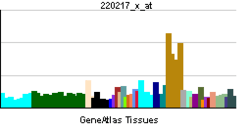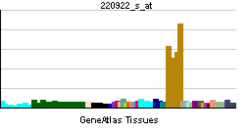Sperm protein associated with the nucleus, X-linked, family member A1
| SPANXA1
|
|---|
|
| Identifiers |
|---|
| Aliases |
SPANXA1, CT11.1, NAP-X, SPAN-X, SPAN-Xa, SPAN-Xb, SPANX, SPANX-A, Sperm protein associated with the nucleus, X-linked, family member A1 |
|---|
| External IDs |
HomoloGene: 88477 GeneCards: SPANXA1
|
|---|
|
|
| RNA expression pattern |
|---|

 |
| More reference expression data
|
| Orthologs |
|---|
| Species |
Human |
Mouse |
|---|
| Entrez |
|
|
|---|
| Ensembl |
|
|
|---|
| UniProt |
|
|
|---|
| RefSeq (mRNA) |
| |
|---|
| RefSeq (protein) |
| |
|---|
| Location (UCSC) |
Chr X: 141.58 – 141.7 Mb |
n/a |
|---|
| PubMed search |
[1] |
n/a
|
|---|
| Wikidata |
Sperm protein associated with the nucleus on the X chromosome A is a protein that in humans is encoded by the SPANXA1 gene.[2][3]
"Temporally regulated transcription and translation of several testis-specific genes is required to initiate the series of molecular and morphological changes in the male germ cell lineage necessary for the formation of mature spermatozoa. This gene is a member of the SPANX family of cancer/testis-associated genes, which are located in a cluster on chromosome X. The SPANX genes encode differentially expressed testis-specific proteins that localize to various subcellular compartments. This particular gene maps to chromosome X in a head-to-head orientation with SPANX family member A2, which appears to be a duplication of the A1 locus. The protein encoded by this gene targets to the nucleus where it associates with nuclear vacuoles and the redundant nuclear envelope. Based on its association with these poorly characterized regions of the sperm nucleus, this protein provides a biochemical marker to study unique structures in spermatazoa [sic] while attempting to further define its role in spermatogenesis."[3]
References
- ↑ "Human PubMed Reference:".
- ↑ Westbrook VA, Diekman AB, Klotz KL, Khole VV, von Kap-Herr C, Golden WL, Eddy RL, Shows TB, Stoler MH, Lee CY, Flickinger CJ, Herr JC (Oct 2000). "Spermatid-specific expression of the novel X-linked gene product SPAN-X localized to the nucleus of human spermatozoa". Biol Reprod. 63 (2): 469–81. PMID 10906052.
- 1 2 "Entrez Gene: SPANXA1 sperm protein associated with the nucleus, X-linked, family member A1".
Further reading
- Westbrook VA, Diekman AB, Naaby-Hansen S, et al. (2001). "Differential nuclear localization of the cancer/testis-associated protein, SPAN-X/CTp11, in transfected cells and in 50% of human spermatozoa.". Biol. Reprod. 64 (1): 345–58. doi:10.1095/biolreprod64.1.345. PMID 11133693.
- Strausberg RL, Feingold EA, Grouse LH, et al. (2003). "Generation and initial analysis of more than 15,000 full-length human and mouse cDNA sequences.". Proc. Natl. Acad. Sci. U.S.A. 99 (26): 16899–903. doi:10.1073/pnas.242603899. PMC 139241
 . PMID 12477932.
. PMID 12477932.
- Zendman AJ, Zschocke J, van Kraats AA, et al. (2003). "The human SPANX multigene family: genomic organization, alignment and expression in male germ cells and tumor cell lines.". Gene. 309 (2): 125–33. doi:10.1016/S0378-1119(03)00497-9. PMID 12758128.
- Westbrook VA, Schoppee PD, Diekman AB, et al. (2004). "Genomic organization, incidence, and localization of the SPAN-x family of cancer-testis antigens in melanoma tumors and cell lines.". Clin. Cancer Res. 10 (1 Pt 1): 101–12. doi:10.1158/1078-0432.ccr-0647-3. PMID 14734458.
- Gerhard DS, Wagner L, Feingold EA, et al. (2004). "The status, quality, and expansion of the NIH full-length cDNA project: the Mammalian Gene Collection (MGC).". Genome Res. 14 (10B): 2121–7. doi:10.1101/gr.2596504. PMC 528928
 . PMID 15489334.
. PMID 15489334.
- Ross MT, Grafham DV, Coffey AJ, et al. (2005). "The DNA sequence of the human X chromosome.". Nature. 434 (7031): 325–37. doi:10.1038/nature03440. PMC 2665286
 . PMID 15772651.
. PMID 15772651.
- Kouprina N, Pavlicek A, Noskov VN, et al. (2006). "Dynamic structure of the SPANX gene cluster mapped to the prostate cancer susceptibility locus HPCX at Xq27.". Genome Res. 15 (11): 1477–86. doi:10.1101/gr.4212705. PMC 1310635
 . PMID 16251457.
. PMID 16251457.
- Salemi M, Calogero AE, Castiglione R, et al. (2006). "Expression of SpanX proteins in normal testes and in testicular germ cell tumours.". Int. J. Androl. 29 (2): 368–73. doi:10.1111/j.1365-2605.2005.00615.x. PMID 16390498.


 . PMID 12477932.
. PMID 12477932. . PMID 15489334.
. PMID 15489334. . PMID 15772651.
. PMID 15772651. . PMID 16251457.
. PMID 16251457.